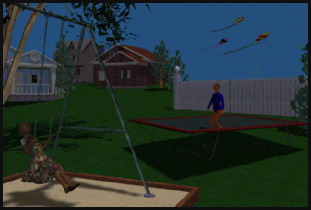
Jessica K. Hodgins
James F. O'Brien
Victor B. Zordan
The secondary motion of passive objects in the scene is essential for appealing and natural-looking animated characters[1], but because of the difficulty of controlling the motion of the primary character, most research in computer animation has largely ignored secondary motion. We use dynamic simulation to generate secondary motion. Simulation is an appropriate technique because secondary motion is passive, dictated only by forces from the environment or the primary actor and not from an internal source of energy in the object itself. Secondary motion does not lend itself easily to keyframing, procedural approaches, or motion capture because of the many degrees of freedom that must move in synchrony with the primary motion of the animated figure.
Passive simulations have been used with great success for many systems, including water, cloth, flags, and leaves blowing in the wind. Active simulations have been used to animate the motion of running, walking, jumping, diving, and vaulting human figures. We explore the interactions between passive and active simulations by coupling passive simulations of objects in the environment with active, rigid body simulations of humans to compute secondary motion for animated figures. We describe several examples: a gymnast on a trampoline, a bungee jumper, a gymnast vaulting onto a mat, a girl swinging while wearing a skirt, and kites in the air.
The primary contribution of this work is an exploration of three different kinds of coupling between passive and the active simulations: full, partial, and one-way. To clarify the differences between the forms of coupling, we use the interaction between a basketball (primary) and the net (secondary) as an example. If the coupling is one-way, the direction and velocity of the ball are not affected by the motion of the net, and the ball continues on a ballistic trajectory. If the two simulations are fully coupled, the rotational and linear velocity of the ball will be changed by the contact with the net, the deformation of the net will be less extreme, and the motion will more closely match that of an actual basketball net. In between these two solutions are a variety of partially coupled solutions. For example, a heuristic drag constant might be applied to the velocity of the ball when it is in contact with the net.
The physics of the particular situation and the fidelity of the required motion dictate how tightly the simulations must be coupled. In some situations, substantial computational savings can be achieved with little loss of realism, but in others tight coupling is essential. The gymnast jumping on the trampoline and the bungee jumper are examples of systems where the interaction forces must be applied to both the passive and the active simulations. In contrast, the girl on a swing is an example of a system where it is sufficient to have a one-way interaction: the active simulation of the swinger affects the passive simulation of the clothing but the passive simulation does not influence the rigid body motion. A final set of problems are amenable to the use of a simplified passive model that is fully coupled to the rigid body model and a more complete passive model that is driven by the motion from the rigid body system. For example, the vaulter is fully coupled to a simple model of a mat with vertical springs and the resulting motion of the feet is used to drive a more realistic simulation of a flexible mat.
The decision about the degree to which the systems are coupled is similar to the modeling decision about the level of detail required for a physical simulation. In the physical world, all interacting objects are coupled and movement includes a remarkable amount of perceptible detail. Each decision to ignore a potential coupling or use a more approximate model will result in some loss of realism. In the case of the basketball and net, the motion of the ball in the fully coupled simulation much more closely matches the real world than the motion produced by one-way coupling. However, with appropriate selection of the simulation parameters either motion might be appropriate for a background element in a scene.
Although we are often not consciously aware of secondary motions, they add greatly to the perceived realism of an animated scene. While we have simulated the secondary motion of some of the objects in the scene, many objects are still motionless. In some cases, it appears that modeling some of the moving and flexible objects emphasizes the lack of motion in the others. Like the progression in models from wireframe to polygonal models, this increase in the fidelity of the modeling may increase the viewer's expectations.
[1] F. Thomas and O. Johnston. Disney Animation: The Illusion of Life. Abbeville Press, New York, 1984.